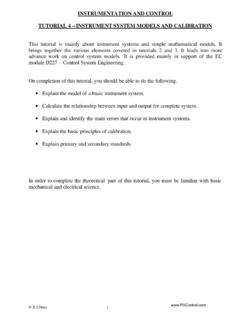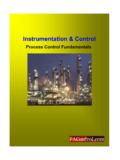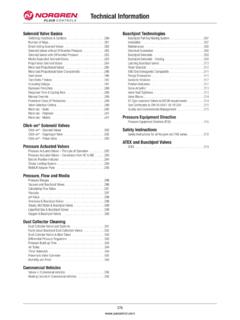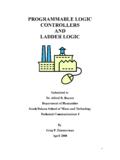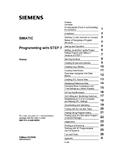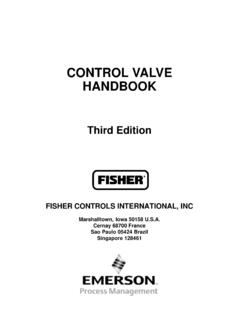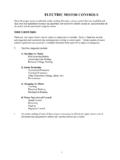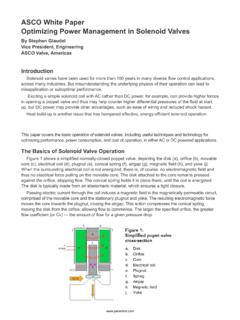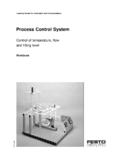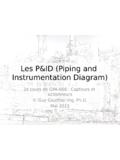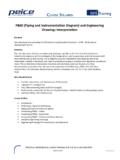Transcription of Flowsheets A sketches and drawings which are his pictures.
1 2 Flowsheets plant design is made up of words, numbers, and pictures. An engineer thinks naturally in terms of the sketches and drawings which are his "pictures. " A Thus, to solve a material balance problem, he will start with a block to represent the equipment and then will show entering and leaving streams with their amounts and properties. Or ask him to describe a process and he will begin to sketch the equipment, show how it is interconnected, and what the flows and operating conditions are. Such sketches develop into flow sheets, which are more BLOCK Flowsheets At an early stage or to provide an overview of a complex process or plant, a drawing is made with rectangular blocks to represent individual processes or groups of operations, together with quantities and other pertinent properties of key streams between the blocks and into and from the process as a whole.
2 Such block Flowsheets are made at the beginning of a process design for orientation purposes or later as a summary of the material balance of the process. For example, the coal carbonization process of Figure starts with 100,000Ib/hr of coal and some process air, involves six main process units, and makes the indicated quantities of ten different products. When it is of particular interest, amounts of utilities also may be shown; in this example the use of steam is indicated at one point. The block diagram of Figure was prepared in connection with a study of the modification of an existing petroleum refinery.
3 The three feed stocks are separated into more than 20 products. Another representative petroleum refinery block diagram, in Figure , identifies the various streams but not their amounts or conditions. PROCESS Flowsheets elaborate diagrammatic representations of the equipment, the sequence of operations, and the expected performance of a proposed plant or the actual performance of an already operating one. For clarity and to meet the needs of the various persons engaged in design, cost estimating, purchasing, fabrication, opera tion, maintenance, and management, several different kinds of Flowsheets are necessary.
4 Four of the main kinds will be described and illustrated. Characteristics of the streams such as temperature, pressure, enthalpy, volumetric flow rates, etc., sometimes are conveniently included in the tabulation. In the interest of clarity, however, in some instances it may be preferable to have a separate sheet for a voluminous material balance and related stream information. A process flowsheet of the dealkylation of toluene to benzene is in Figure ; the material and enthalpy flows and temperature and pressures are tabulated conveniently, and basic instrumentation is represented.
5 MECHANICAL (P&I) Flowsheets Mechanical Flowsheets also are called piping and instrument (P&I) diagrams to emphasize two of their major characteristics. They do not show operating conditions or compositions or flow quantities, but they do show all major as well as minor equipment more realistically than on the process flowsheet . Included are sizes and specification classes of all pipe lines, all valves, and all instruments. In fact, every mechanical aspect of the plant regarding the process equipment and their interconnections is represented except for supporting structures and foundations.
6 The equipment is shown in greater detail than on the PFS, notably'with regard to external piping connections, internal details, and resemblance to the actual Process Flowsheets embody the material and energy balances between and the sizing of the major equipment of the plant. They include all vessels such as reactors, separators, and drums; special processing equipment, heat exchangers, pumps, and so on. Numerical data include flow quantities, compositions, pressures, temperatures, and so on. Inclusion of major instrumentation that is essential to process control and to complete understanding of the flowsheet without reference to other information is required particularly during the early stages of a job, since the process flowsheet is drawn first and is for some time the only diagram Rowsheet gets underway, instrumentation may be taken off the process diagram to reduce the clutter.
7 A checklist of the information that usually is included on a process flowsheet is given in Table Working Flowsheets are necessarily elaborate and difficult to represent on the page of a book. Figure originally was 30in. wide. In this process, ammonia is made from available hydrogen supplemented by hydrogen from the air oxidation of natural gas in a two-stage reactor F-3 and V-5. A large part of the plant is devoted to purification of the feed gases of carbon dioxide and unconverted methane before they enter the converter CV-1. Both commercial and refrigeration grade ammonia are made in this plant.
8 Com- positions of 13 key streams are summarized in the tabulation. appearance' The mechanical flowsheet of the reaction section of a toluene dealkylation unit in Figure shows all instrumentation, including indicators and transmitters. The clutter on the diagram is minimized by tabulating the design and operating conditions of the major equipment below the diagram. The P&I diagram of Figure represents a gas treating plant that consists of an amine absorber and a regenerator and their immediate auxiliaries. Internals of the towers are shown with exact locations of inlet and outlet connections.
9 The amount of surprising. On a completely finished diagram, every line will carry a code designation identifying the size, the kind of fluid handled, the pressure rating, and material specification. Complete information about each line-its length, size, elevation, pressure drop, fittings, recorded in a separate line summary. On Figure , which is of an early stage of construction, only the sizes of the lines are shown. Although instrumentation symbols are fairly well standard- ized7 they are Often diagram as in this representing the process, As the design develops and a mechanical instrumentation for such a simp1e process may be On the These are P&I diagrams for individual utilities such as steam, steam condensate, cooling water, heat transfer media in general, 20 Flowsheets Coal 100,000 Air t * Net Fuel Gas 71 83 Fractionator 22,500 Light Aromatics 770 - Middle Oils (diesel, etc.)
10 12575 Sulfur 1070 Sulfur Recovery I Tar Acids 3320 - L 2380 Pitch Heavy Oils (creosote, etc.) Phenols 25 * I Net Waste Liquids 2380 Carbonizer n Primary Distillation Figure Coal carbonization block flowsheet . Quantities are in Ib/hr compressed air, fuel, refrigerants, and inert blanketing gases, and how they are piped up to the process equipment. Connections for utility streams are shown on the mechanical flowsheet , and their conditions and flow quantities usually appear on the process flowsheet . Since every detail of a plant design must be recorded on paper, many other kinds of drawings also are required: for example, electrical flow, piping isometrics, instrument lines, plans and elevations, and individual equipment drawings in all detail.
